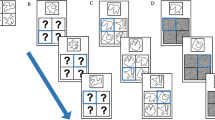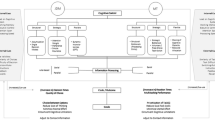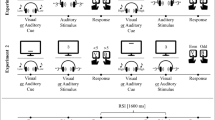Abstract
Dual-task costs depend on the specific pairings of stimulus and response modalities. Such findings are analogous to domain-specific effects in the working memory (WM) literature, in which items compete for limited capacity when they involve related types of information. The present study explicitly examines the relationship between modality-pairing effects on dual-task costs and domain-specificity effects on WM capacity. Participants maintained a sequence of either locations or tones in WM, and then performed a choice reaction time task in which they responded either vocally or manually. The stimuli for the choice reaction time task were held constant, but its response modality affected the interference observed in WM: vocal responses interfered with WM for tones and manual responses interfered with WM for locations. These findings indicate that response selection engages domain-specific WM processes and that interference within these processes may account for modality-pairing effects.


Similar content being viewed by others
References
Anderson, J. R., Bothell, D., Byrne, M. D., Douglass, S., Lebiere, C., & Qin, Y. (2004). An integrated theory of the mind. Psychological Review, 111, 1036–1060.
Anderson, J. R., Taatgen, N. A., & Byrne, M. D. (2005). Learning to achieve perfect timesharing: Architectural implications of Hazeltine, Teague, and Ivry (2002). Journal of Experimental Psychology: Human Perception and Performance, 31, 749–761.
Baddeley, A. D. (1986). Working memory. Oxford: Oxford University Press.
Baddeley, A., Grant, S., Wight, E., & Thomson, N. (1975). Imagery and visual working memory. In P. M. A. Rabbitt & S. Dornic (Eds.), Attention and Performance (Vol. 5) (pp. 205–217). London: Academic Press.
Baddeley, A., & Hitch, G. J. (1974). Working memory. In G. H. Bower (Ed.), The psychology of learning and motivation: Advances in research and theory (Vol. 8) (pp. 47–89). New York: Academic Press.
Baddeley, A., & Logie, R. H. (1999). Working memory: The multiple-component model. In M. Akira & P. Shah (Eds.), Models of working memory: Mechanisms of active maintenance and executive control (pp. 28–61). New York, NY: Cambridge University Press.
Cocchini, G., Logie, R. H., Della Sala, S., MacPherson, S. E., & Baddeley, A. D. (2002). Concurrent performance of two memory tasks: Evidence for domain-specific working memory systems. Memory and Cognition, 30, 1086–1095.
Cowan, N. (2000). The magical number 4 in short-term memory: A reconsideration of mental storage capacity. Behavioral and Brain Sciences, 24, 87–185.
Engle, R. W. (2002). Working memory capacity as executive attention. Current Directions in Psychological Science, 11, 19–23.
Engle, D. J., & Kane, M. J. (2004). Executive attention, working memory capacity, and a two-factor theory of cognitive control. In B. Ross (Ed.), The psychology of learning and motivation (Vol. 44) (pp. 145–199). New York: Elsevier.
Fitts, P. M., & Deininger, R. L. (1954). S–R Compatibility: Correspondence among paired elements within stimulus and response codes. Journal of Experimental Psychology, 48, 483–492.
Hazeltine, E., & Ruthruff, E. (2006). Modality pairing effects and the response selection bottleneck. Psychological Research, 70, 504–513.
Hazeltine, E., Ruthruff, E., & Remington, R. W. (2006). The role of input and output modality pairings in dual-task performance: Evidence for content-dependent central interference. Cognitive Psychology, 52, 291–345.
Hazeltine, E., Teague, D., & Ivry, R. B. (2002). Simultaneous dual-task performance reveals parallel response selection after practice. Journal of Experimental Psychology: Human Perception and Performance, 28, 527–545.
Heuer, H. (1995). Models for response–response compatibility: The effects of the relation between responses in a choice task. Acta Psychologia, 90, 315–332.
Huestegge, L., & Koch, I. (2010). Crossmodal action selection: Evidence from dual-task compatibility. Memory & Cognition, 38, 493–501.
Lavie, N., Hirst, A., de Fockert, J. W., & Viding, E. (2004). Load theory of selective attention and cognitive control. Journal of Experimental Psychology: General, 133, 339–354.
Logan, G. D. (1979). On the use of a concurrent memory load to measure attention and automaticity. Journal of Experimental Psychology: Human Perception and Performance, 5, 189–207.
Maquestiaux, F., Laguë-Beauvais, M., Ruthruff, E., & Bherer, L. (2008). Bypassing the central bottleneck after single-task practice in the psychological refractory period paradigm: Evidence for task automatization and greedy resource recruitment. Memory & Cognition, 37, 1262–1282.
McCann, R. S., & Johnston, J. C. (1992). Locus of the single-channel bottleneck in dual-task interference. Journal of Experimental Psychology: Human Perception and Performance, 18, 471–484.
Meyer, D. E., & Kieras, D. E. (1997). A computational theory of human multiple task performance: The EPIC information-processing architecture and strategic response deferment model. Psychological Review, 104, 1–65.
Navon, D. (1984). Resources—A theoretical soupstone? Psychological Review, 91, 216–234.
Navon, D., & Gopher, D. (1979). On the economy of the human-processing system. Psychological Review, 86, 214–255.
Navon, D., & Miller, J. (2002). Queuing or sharing? A critical evaluation of the single-bottleneck notion. Cognitive Psychology, 44, 193–251.
Pashler, H. (1984). Processing stages in overlapping tasks: Evidence for a central bottleneck. Journal of Experimental Psychology: Human Perception and Performance, 10, 358–377.
Pashler, H. (1994). Dual-task interference in simple tasks: Data and theory. Psychological Bulletin, 116, 220–244.
Pashler, H., & Johnston, J. C. (1989). Chronometric evidence for central postponement in temporally overlapping tasks. Quarterly Journal of Experimental Psychology, 41A, 19–45.
Ruthruff, E., Pashler, H., & Hazeltine, E. (2003). Dual-task interference with equal task emphasis: Graded capacity sharing or central postponement? Perception & Psychophysics, 65, 801–816.
Schumacher, E. H., Seymour, T. L., Glass, J. M., Kieras, D. E., & Meyer, D. E. (2001). Virtually perfect time sharing in dual-task performance: Uncorking the central attentional bottleneck. Psychological Science, 12, 101–108.
Stelzel, C., Schumacher, E. H., Schubert, T., & D’Esposito, M. (2006). The neural effect of stimulus-response modality compatibility on dual-task performance: an fMRI study. Psychological Research, 70, 514–525.
Ulrich, R., & Miller, J. O. (2008). Response grouping in the psychological refractory period (PRP) paradigm: Models and contamination effects. Cognitive Psychology, 57, 75–121.
Wickens, C. D. (1980). The structure of attentional resources. In R. Nickerson (Ed.), Attention and Performance (Vol. VIII, pp. 239–257). Hillsdale: Erlbaum.
Wickens, C. D. (1984). Processing resources in attention. In R. Parasuraman & D. R. Davies (Eds.), Varieties of Attention (pp. 63–102). Orlando: Academic Press.
Wickens, C. D., & Liu, Y. (1988). Codes and modalities in multiple resources: A success and a qualification. Human Factors, 30, 599–616.
Wickens, C. D., Sandry, D. L., & Vidulich, M. (1983). Compatibility and resource competition between modalities of input, central processing and output. Human Factors, 25, 227–248.
Zhao, X., Chen, A., & West, R. (2010). The influence of working memory load on the Simon effect. Psychonomic Bulletin & Review, 17, 687–692.
Author information
Authors and Affiliations
Corresponding author
Rights and permissions
About this article
Cite this article
Hazeltine, E., Wifall, T. Searching working memory for the source of dual-task costs. Psychological Research 75, 466–475 (2011). https://doi.org/10.1007/s00426-011-0343-6
Received:
Accepted:
Published:
Issue Date:
DOI: https://doi.org/10.1007/s00426-011-0343-6




